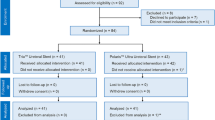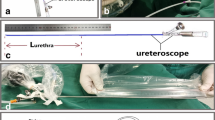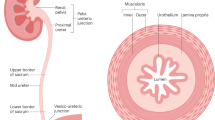Abstract
Ureteral stents are an important tool for aiding upper urinary tract drainage, but can cause significant patient morbidity. Common problems include stent-induced pain, hematuria, dysuria, infection, and encrustation. From a urologist's perspective, stents must be easy to maneuver in the urinary tract, radiopaque, and affordable. Since the development of the modern day stent in 1978, stents have evolved to include softer biomaterials that are more resistant to encrustation and infection. An ideal biomaterial is one that is not affected by its environment and does not elicit reactive changes in surrounding tissues. To date, the ideal biomaterial or stent does not exist. This review discusses developments that address the issues of infection, biofilm formation, encrustation, and patient comfort. Stent materials including polyurethane, silicone, biodegradable substances and new combination polymers are reviewed, in addition to novel stent coatings such as heparin, hydrogel, and silver nitrate. Ureteral stent technologies currently lag behind vascular stents, particularly drug-eluting stents, but new developments will continue to improve these essential urological tools.
This is a preview of subscription content, access via your institution
Access options
Subscribe to this journal
Receive 12 print issues and online access
$209.00 per year
only $17.42 per issue
Buy this article
- Purchase on Springer Link
- Instant access to full article PDF
Prices may be subject to local taxes which are calculated during checkout
Similar content being viewed by others
References
Houghton Mifflin Company (2000) The American Heritage® Dictionary of the English Language, edn 4. Boston: Houghton Mifflin Company
Bloom DA et al. (1999) Stents and related terms: a brief history. Urology 54: 767–771
Finney RP (1978) Experience with new double J ureteral catheter stent. J Urol 120: 678–681
Paick SH et al. (2003) Characteristics of bacterial colonization and urinary tract infection after indwelling of double-J ureteral stent. Urology 62: 214–217
Damiano R et al. (2002) Early and late complications of double pigtail ureteral stent. Urol Int 69: 136–140
Singh I et al. (2001) Severely encrusted polyurethane ureteral stents: management and analysis of potential risk factors. Urology 58: 526–531
Riedl CR et al. (1999) Bacterial colonization of ureteral stents. Eur Urol 36: 53–59
Joshi HB et al. (2003) Indwelling ureteral stents: evaluation of symptoms, quality of life and utility. J Urol 169: 1065–1069
Hosking DH et al. (1999) Is stenting following ureteroscopy for removal of distal ureteral calculi necessary? J Urol 161: 48–50
Denstedt JD et al. (2001) A prospective randomized controlled trial comparing nonstented versus stented ureteroscopic lithotripsy. J Urol 165: 1419–1422
Damiano R et al. (2004) Stent positioning after ureteroscopy for urinary calculi: the question is still open. Eur Urol 46: 381–387
Gorman SP et al. (1998) Characterization and assessment of a novel poly(ethylene oxide)/polyurethane composite hydrogel (Aquavene) as a ureteral stent biomaterial. J Biomed Mater Res 39: 642–649
Watterson JD et al. (2003) Swarming of Proteus mirabilis over ureteral stents: a comparative assessment. J Endourol 17: 523–527
Tunney MM et al. (1997) Assessment of urinary tract biomaterial encrustation using a modified Robbins device continuous flow model. J Biomed Mater Res 38: 87–93
Jones DS et al. (2004) Relationship between biomedical catheter surface properties and lubricity as determined using textural analysis and multiple regression analysis. Biomaterials 25: 1421–1428
Marx M et al. (1988) The effects of various indwelling ureteral catheter materials on the normal canine ureter. J Urol 139: 180–185
Mardis HK and Kroeger RM (1988) Ureteral stents. Materials. Urol Clin North Am 15: 471–479
Choong S and Whitfield H (2000) Biofilms and their role in infections in urology. BJU Int 86: 935–941
Tieszer C et al. (1998) Conditioning film deposition on ureteral stents after implantation. J Urol 160: 876–881
Reid G et al. (2001) Oral fluoroquinolone therapy results in drug adsorption on ureteral stents and prevention of biofilm formation. Int J Antimicrob Agents 17: 317–319
Multanen M et al. (2000) Bacterial adherence to silver nitrate coated poly-L-lactic acid urological stents in vitro. Urol Res 28: 327–331
Multanen M et al. (2002) Biocompatibility, encrustation and biodegradation of ofloxacine and silver nitrate coated poly-L-lactic acid stents in rabbit urethra. Urol Res 30: 227–232
Riedl CR et al. (2002) Heparin coating reduces encrustation of ureteral stents: a preliminary report. Int J Antimicrob Agents 19: 507–510
Marmieri G et al. (1996) Evaluation of slipperiness of catheter surfaces. J Biomed Mater Res 33: 29–33
Desgrandchamps F et al. (1997) An in vitro comparison of urease-induced encrustation of JJ stents in human urine. Br J Urol 79: 24–27
Zupkas P et al. (2000) Pentosanpolysulfate coating of silicone reduces encrustation. J Endourol 14: 483–488
Stickler DJ et al. (2002) Strategies for the control of catheter encrustation. Int J Antimicrob Agents 19: 499–506
Tunney MM and Gorman SP (2002) Evaluation of a poly(vinyl pyrollidone)-coated biomaterial for urological use. Biomaterials 23: 4601–4608
Chitale SV et al. (2002) The management of ureteric obstruction secondary to malignant pelvic disease. Clin Radiol 57: 1118–1121
Pauer W and Lugmayr H (1992) Metallic Wallstents: a new therapy for extrinsic ureteral obstruction. J Urol 148: 281–284
Kulkarni R and Bellamy E (2001) Nickel-titanium shape memory alloy Memokath 051 ureteral stent for managing long-term ureteral obstruction: 4-year experience. J Urol 166: 1750–1754
Daskalopoulos G et al. (2001) Intraureteral metallic endoprosthesis in the treatment of ureteral strictures. Eur J Radiol 39: 194–200
Barbalias GA et al. (2002) Ureteropelvic junction obstruction: an innovative approach combining metallic stenting and virtual endoscopy. J Urol 168: 2383–2386
Barbalias GA et al. (2002) Externally coated ureteral metallic stents: an unfavorable clinical experience. Eur Urol 42: 276–280
Amiel GE et al. (2001) Tissue engineered stents created from chondrocytes. J Urol 165: 2091–2095
Smith TG III et al. (2002) Ureteral replacement using porcine small intestine submucosa in a porcine model. Urology 60: 931–934
Landman J et al. (2004) Laparoscopic mid sagittal hemicystectomy and bladder reconstruction with small intestinal submucosa and reimplantation of ureter into small intestinal submucosa: 1-year followup. J Urol 171: 2450–2455
O'Connor RC et al. (2002) Distal ureteral replacement with tubularized porcine small intestine submucosa. Urology 60: 697
Dunn MD et al. (2000) Clinical effectiveness of new stent design: randomized single-blind comparison of tail and double-pigtail stents. J Endourol 14: 195–202
Liatsikos EN et al. (2002) Tail stent versus re-entry tube: a randomized comparison after percutaneous stone extraction. Urology 59: 15–19
Stoller ML et al. (2000) An in vitro assessment of the flow characteristics of spiral-ridged and smooth-walled JJ ureteric stents. BJU Int 85: 628–631
Isotalo T et al. (2002) A bioabsorbable self-expandable, self-reinforced poly-L-lactic acid urethral stent for recurrent urethral strictures: long-term results. J Endourol 16: 759–762
Laaksovirta S et al. (2002) Interstitial laser coagulation and biodegradable self-expandable, self-reinforced poly-L-lactic and poly-L-glycolic copolymer spiral stent in the treatment of benign prostatic enlargement. J Endourol 16: 311–315
Olweny EO et al. (2002) Evaluation of the use of a biodegradable ureteral stent after retrograde endopyelotomy in a porcine model. J Urol 167: 2198–2202
Taylor WN and McDougall IT (2002) Minimally invasive ureteral stent retrieval. J Urol 168: 2020–2023
Lingeman JE et al. (2003) Phase I trial of a temporary ureteral drainage stent. J Endourol 17: 169–171
Granada JF et al. (2003) Drug-eluting stents for cardiovascular disorders. Curr Atheroscler Rep 5: 308–316
Beiko DT et al. A double-blinded prospective randomized controlled trial assessing the safety and efficacy of intravesical agents for ureteral stent symptoms following extracorporeal shockwave lithotripsy. J Endourol, in press
Watterson JD et al. (2003) Oxalate-degrading enzymes from Oxalobacter formigenes: a novel device coating to reduce urinary tract biomaterial-related encrustation. J Endourol 17: 269–274
Mittelman M et al. (2004) In vitro antimicrobial release profile of a new triclosan-eluting ureteral stent. J Urol 171: 443
Chew BH et al. (2004) Triclosan loaded ureteral stents reduce Proteus mirabilis 296 infection in a rabbit UTI model. In Proceedings of the 56th Annual Meeting of the Northeastern Section of the American Urological Association: October 28–30, 2004; Savannah, Georgia, in press
Author information
Authors and Affiliations
Corresponding author
Ethics declarations
Competing interests
The authors receive funding and research support from Cook Urological, ACMI Corporation and Boston Scientific Corporation.
Rights and permissions
About this article
Cite this article
Chew, B., Denstedt, J. Technology Insight: novel ureteral stent materials and designs. Nat Rev Urol 1, 44–48 (2004). https://doi.org/10.1038/ncpuro0014
Received:
Accepted:
Issue Date:
DOI: https://doi.org/10.1038/ncpuro0014
This article is cited by
-
Laparoscopic single-incision triangulated umbilical surgery (SITUS) pyeloplasty: a description of the first 32 cases
World Journal of Urology (2018)
-
Minimal Device Encrustation on Vesair Intravesical Balloons in the Treatment of Stress Urinary Incontinence: Analysis of Balloons Removed from Women in the SOLECT Trial
Advances in Therapy (2017)
-
The role of pregabalin in relieving ureteral stent-related symptoms: a randomized controlled clinical trial
International Urology and Nephrology (2017)



